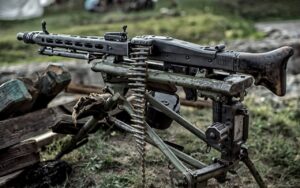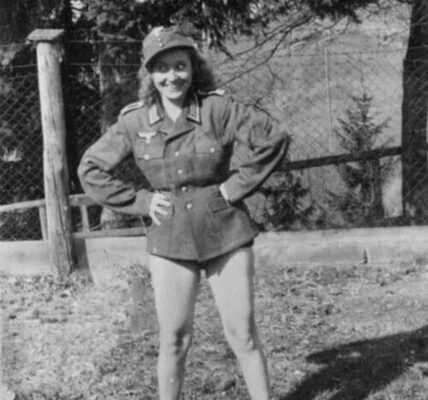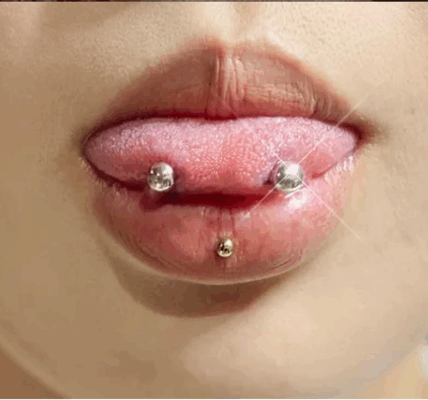The MG34 delivered devastating fire during Germany’s Blitzkrieg victories at the beginning of World War II, but the MG42, which was intended to replace it, had the greatest impact since the end of the war. As good as the MG34 was, it was too expensive and time-consuming to produce for Germany’s wartime needs. Designs for a replacement were being considered as early as 1937, so the cheaper MG42 went into production in 1942. Although the MG34 remained in production until the end of the war, approximately 75,000 more MG42s were produced. While the MG42 was still a well-made weapon, machining was not as precise as the MG34, which improved its reliability in dust, snow, mud, and other conditions. One of the most notable features of the MG42, especially among those who faced it in combat, was its high rate of fire: 1,200 rounds per minute!

Like the MG34, the MG42 was recoil-operated and air-cooled. However, it featured a recoil-operated roller lock. Simply put, the bolt was equipped with rollers; upon entering the barrel extension, these rollers engaged grooves in the barrel extension. When the expansion chamber in the MG42’s muzzle mechanism forced gases against the locked barrel and bolt, the rollers were released from their locking grooves, allowing the bolt to move rearward and engage the breech. Additionally, the MG42 utilized carbon steel pressed and stamped parts, which were spot-welded and riveted wherever possible. This meant that the production of an MG42 required only about half the labor hours of an MG34 and about 60% of the raw materials.
Prototypes proved more robust and reliable than the MG34 in testing. The MG42’s quick-change barrel could be changed quickly (four to seven seconds by an experienced assistant gunner), but the system was not suitable for changing machine guns in armored vehicles, as tanks were manufactured with mounting points designed for the MG34. In addition, the MG42’s barrel had to be changed sideways through the sleeve, which was difficult in armored vehicles. Due to the MG42’s high firing rate, the barrel heated up more quickly, requiring frequent barrel changes. However, the use of the quick-change barrel was essential in combat; therefore, MG34s remained standard in many vehicles. The continued use of the MG34, which was prone to jamming, later led to complaints from some tank officers on the Eastern Front.
The new machine gun was officially introduced in early 1942. Production took place at Großfuß AG, Mauser-Werke AG, Gustloff-Werke, Steyr-Daimler-Puch, and MAGET (Maschinenbau und Gerätebau GmbH, Berlin-Tegel). After its introduction, the MG42 proved its reliability in the sands of North Africa and the ice, mud, and snow of Russia. Even after the MG42 had proven itself in combat, German engineers continued to experiment to make it faster and more cost-effective while maintaining its effectiveness. However, with Germany on the defensive in all theaters of war, there was little interest in optimizing the assembly lines.

Interestingly, MG42 gunners were trained to fire the weapon from the hip, using their biceps to press the stock against their body and grip the folded bipod with their support hand. Presumably, the sling was only used if the gunner was very strong. This is especially the case when combat fatigue and lack of hot food have taken their toll, although firing a few bursts can certainly be an adrenaline boost. Typically, however, in most combat scenarios, the gunner fired from the bipod while prone or from the cover of the tripod. From what I’ve read, German gunners were trained to fire bursts of five to ten rounds in most combat situations. German gunners were also trained to fire up to 15 well-aimed bursts per minute. Based on my experience with the MG42, I agree that this is a sensible tactical use for the weapon, especially given its high rate of fire, which would likely compromise control during longer bursts. I found that recoil and vibration were noticeable during longer bursts.

Because a large portion of German infantrymen during World War II were armed with .98k caliber repeating rifles, the Wehrmacht issued more machine guns to a typical infantry company than the Americans. While a German infantry company (circa 1944) consisted of 150 men, the TO&E (Table of Organization and Equipment) specified 15 multi-purpose machine guns (GPMGs). By comparison, a US infantry company consisted of approximately 200 men and deployed five BARs (Browning Automatic Rifles) and two M1919A4 machine guns in a light machine gun section. In addition, a US infantry company had a mortar section with three 60 mm mortars. As you can see, the German infantry company, although only about three-quarters the size of a US infantry company, had more than twice as many automatic weapons, and the majority of these in the US company were BARs.






